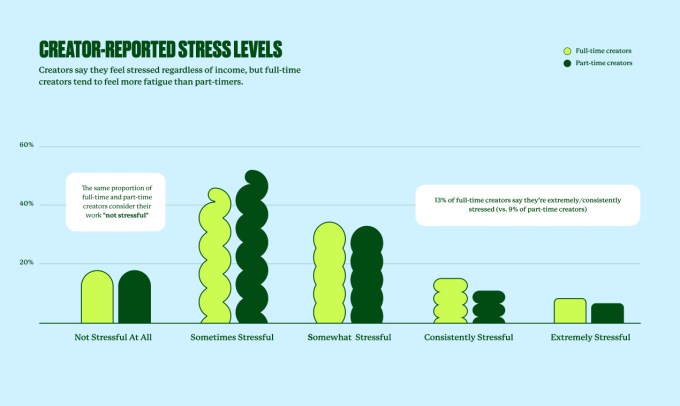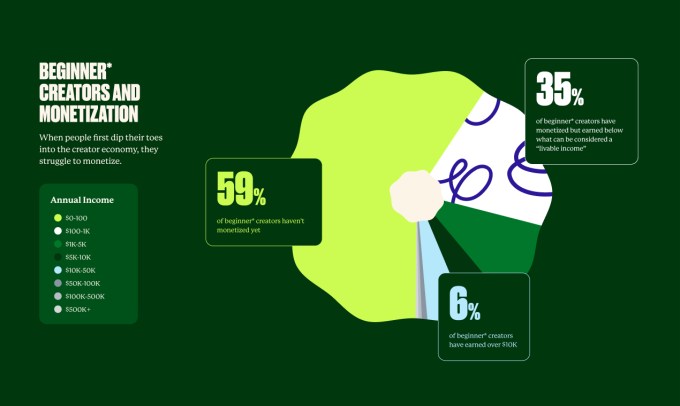Usuarios del Club TRPlane
Aunque la economía del creador está creciendo y cambiando rápidamente, no hay muchos informes sobre su actividad espacio, lo que dificulta que las partes interesadas entiendan lo que sucede detrás del proceso de creación. El unicornio Linktree, publica un informe con los resultados de una encuesta a 9.500 creadores, que ayuda a iluminar algunas tendencias generales sobre cómo éstos intentan tener éxito en las redes sociales.
Es más fácil que nunca convertirse en creador: según las cifras de Linktree, más de 200 millones de personas podrían clasificarse como creadores, lo que la empresa define como cualquier persona que usa su influencia y creatividad para monetizar su audiencia, independientemente de las plataformas que utilice. Pero el estudio desveló que el 39% de los creadores, independientemente de su nivel de ingresos, informaron que deben tomar medidas constantemente para reducir el estrés; de hecho, el 13% de los creadores de tiempo completo dicen que están extremadamente estresados.

Créditos:LinkTree
Esta tensión tiene sentido. Los creadores no solo posan con ropa interesante en Instagram y bailan de cualquier forma en TikTok. Están administrando pequeñas empresas, que a menudo requieren que estén «activas» a todas horas del día, lidiando con un aluvión constante de comentarios de Instagram, correos electrónicos de clientes y probablemente facturas atrasadas, ya que cualquiera que haya realizado algún trabajo independiente sabe que pagar en el tiempo acordado es una casualidad. No se trata solo de publicar videos: se trata de escribir guiones, filmar, editar, comercializar, contabilidad y cualquier otra cosa que requiera una empresa.
Pero una de las revelaciones más impactantes del informe es que los creadores están dejandose el dinero en el proceso, dice Linktree. Solo el 12% de los creadores a tiempo completo ganan más de 50.000 dólares al año, mientras que el 46% de los creadores a tiempo completo ganan menos de 1.000 al año (… lo que plantea la pregunta, ¿quiénes son esas personas que ganan 1000 al año trabajando a tiempo completo? ?¿Hay más influencers aficionados, jubilados de los que se podría pensar?). Linktree también descubrió que no existe una correlación directa entre el tiempo dedicado a la creación de contenido y los ingresos anuales. El 32% de los creadores que ganan hasta 10.000 dólares al año dedican más de diez horas a la semana a la creación de contenido, mientras que el 52% de los creadores que ganan entre 50.000 y 100.000 dedican menos de diez horas a la semana a crear contenido nuevo.
Linktree estima que el 66% de los creadores ven sus actividades online como una actividad secundaria, mientras que el 36% de los creadores solo han estado creando contenido durante un año o menos. De esos creadores, a quienes Linktree clasifica como «principiantes», solo el 6%ha ganado más de 10.000 dólares. El 35% ha monetizado, pero no ha ganado lo suficiente para tener un «ingreso digno», mientras que el 59% no ha monetizado todavía.

Créditos:LinkTree
Un informe anterior sobre la economía de los creadores de Influencer Marketing Hub y Neoreach mostró que los acuerdos con marcas eran la fuente principal de ingresos para los creadores. Pero Linktree confirma que no es cierto. Según los datos de Linktree, el 70 % de los creadores ganan menos del 10% de sus ingresos totales de la asociación de marca, lo que indica que los acuerdos de marca no son fuentes de ingresos confiables ni consistentes. Además, el 12% de los creadores gana menos de 100 dólarespor colaboración de marca.
¡Por favor, valen más que esa cantidad de dinero !. Es incomparable con medios masivos y anuncios generalistas tanto en eficacia, como en creatividad, respeto por la marca, etc
Quizás esto signifique que los creadores se están beneficiando de cosas como los ingresos publicitarios de YouTube, ser miembors de Patreon, las ventas de merchandising, los fondos de los creadores, etc. Además, vale la pena recordar que esta no es una encuesta de una marca específica de influencers; es una encuesta a 9.500 usuarios de Linktree en todo el espacio de creadores. Entonces, mientras que un Instagrammer de recetas podría asociarse con su compañía favorita de fideos sin gluten, un YouTuber podría quedarse con ese dinero de AdSense.
“El 68% de los creadores a tiempo parcial ganan menos de 1K”, dijo Eric Jacks, director de estrategia de Collab, Inc., quien estuvo asociado con Linktree en este estudio. “Esta investigación subraya lo difícil que puede ser conversirtese en creador y lo importante que es para los creadores encontrar socios, plataformas y servicios que agilicen las oportunidades de monetización».
Según estos resultados, Linktree recomienda que los creadores encuentren un nicho específico, citando que el 37% de los creadores de nicho obtuvieron colaboraciones de marca, en comparación con el 26% de creadores más generalistas. Después de todo, hay más competencia en la «cocina» que en los «trucos de cocina para veganos que, lamentablemente, son alérgicos a la soja y, por lo tanto, no pueden comer tofu, tempe o nuggets de pollo congelados».
Finalmente, el demuestra encuentra que tener una audiencia más pequeña y altamente comprometida ayuda a los creadores a monetizar de manera más efectiva que una audiencia grande y mínimamente comprometida. Esto tiene sentido, ya que muchas marcas requieren que los posibles socios influyentes compartan información sobre las tasas de participación de la audiencia, no solo sobre el número de seguidores.
Estos nuevos dato ayudan a comprender mejor la amplitud de la economía del creador y las luchas que enfrentan sus participantes. Pero, por supuesto, ninguna guía para creadores es única.

